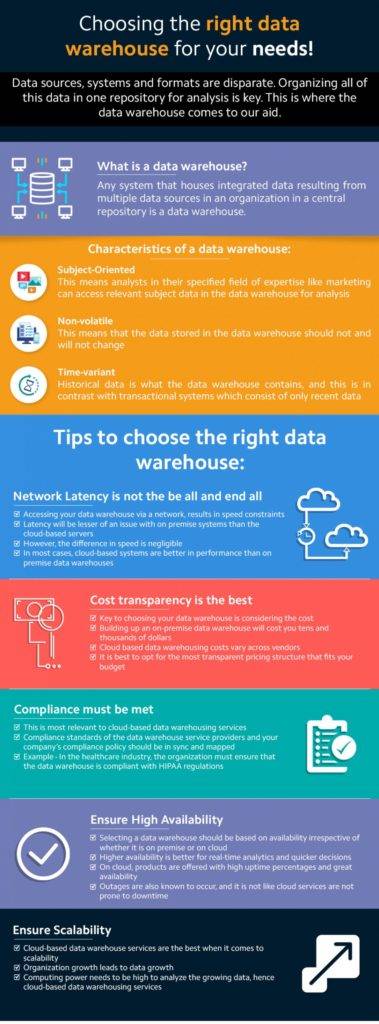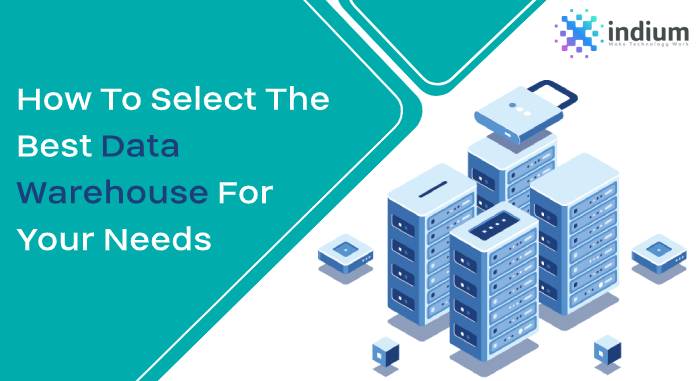- February 22, 2019
- Posted by: Abhimanyu Sundar
- Category: Data engineering

Data-driven decision making is the most fundamental part of any business intelligence strategy for n organization. Most organizations have come to realize that observation and gut instinct are not always enough to make the right decision. Data needs to be at the center of the decision making fulcrum when important enterprise decisions are made.
This brings us to the part where data-driven decision making also faces a problem. The problem arises where collation of all the various sources of data in one repository is required. This is because all the data sources, systems and formats are disparate. What this means is that the need to organize all of this data in one repository for analysis is extremely important. This is where the data warehouse comes to our aid.
So, let’s dive into what a data warehouse is and why you need to invest in the best in class data warehousing services.
What is a Data Warehouse?
Any system that houses integrated data resulting from multiple data sources in an organization in a central repository is a data warehouse. Reporting, analysis and decision making is supported by a data warehouse by consolidating all the data at an aggregate level.
Subject-oriented, non-volatile and time variant were the terms used to describe a data warehouse by Bill Inmon who is regarded as the father of the data warehouse.
Subject-Oriented – This means analysts in their specified field of expertise like marketing can access relevant subject data in the data warehouse for analysis.
Non-volatile – This means that the data stored in the data warehouse should not and will not change.
Time-variant – Historical data is what the data warehouse contains and this is in contrast with transactional systems which consist of only recent data.
Modern Data Warehousing
All aspects of IT architecture have undergone a massive change since the advent of cloud computing. When it comes to data warehouses, enterprises have made a shift from on premise systems to cloud based warehousing services.
The answer to costly investments in hardware is cloud which allows computing access in a cost-effective and convenient way. When it comes to cloud, the organization only pays for the cloud –based services provided and sometimes for the delivery of those services by the computing resources.
More and more companies are shifting to cloud based data warehouse solutions from the traditional on premise data warehouses.
Data Warehouse Use Cases and Vendors
The common notion is that data warehouses help support business decision making, apart from this here are a few use cases that further illustrate this fact:
- Logistics and operations can be reviewed and analyzed, the results of this analysis can be optimized and improved to help run the business unit better.
- Customer relationships (current and prospective) can be improved.
- Performance/profitability can be tracked, analyzed and improved.
- Sales process analysis to be more efficient.
Microsoft, HP, IBM and SAP provide on premise data warehouse systems. These systems are database software optimized for database workloads and analytics. The organization still has to buy the necessary hardware in order to support the software.
On premise data warehouse packages inclusive of hardware and software are provided by companies like IBM, Oracle and Teradata.
When we talk about cloud offerings, these systems are offered as data warehouse as a service. There is no investment required except for the computer and an internet connection to access and analyze the data. In this space, the big players are Amazon Redshift, Panoply, Azure SQL Data Warehouse and Google BigQuery.
Below are a few tips for you to select the right data warehouse:
1. Network Latency is not the be all and end all
There is a lot of debate in the speeds of cloud based services vs on premise deployments. Accessing your data warehouse via a network results in speed constraints. However, this does not have that much of an effect on performance as is popularly assumed.
Latency will be lesser of an issue with on premise systems than the cloud based servers. However, the difference in speed is negligible. In most cases, cloud based systems are better in performance than on premise data warehouses.
2. Cost transparency is the best
Key to choosing your data warehouse is considering the cost. Building up an on premise data warehouse will cost you tens and thousands of dollars. Over and above this will be the cost to maintain and administer the warehouse.
Cloud based data warehousing costs vary across vendors. This is primarily because different vendors offer varied pricing structures. Amazon Redshift charges you based on the type of computing instances need to house the data. On the other hand, BigQuery charges for storage and also for each query after.
It is best to opt for the most transparent pricing structure that fits your budget.
3. Compliance must be met
This is most relevant to cloud based data warehousing services. While choosing a data warehouse product, you need to ensure that the compliance standards of the data warehouse service providers and your company’s compliance policy are in sync and are mapped.
Healthcare information and patient data is strictly governed by HIPAA compliance laws. In the healthcare industry, any organization must ensure that the data warehouse is in compliance with HIPAA regulations.
Leverge your Biggest Asset Data
Inquire Now
4. Ensure High Availability
The prime focus while selecting a data warehouse should be on availability irrespective of whether it is on premise or on cloud. A higher level of availability is expected due to the necessity of data for decisions and the move to real-time analytics.
On cloud, products are offered with high uptime percentages and great availability. Outages are also known to occur and it is not like cloud services are not prone to downtime.
5. Ensure Scalability
Cloud-based data warehouse services excel tremendously when it comes to scalability. Along with the growth of organizations, the amount of data grows as well. This requires more computer power in order to analyze all the data effectively.
Please include attribution to https://www.indiumsoftware.com/blog/ with this graphic.







 Share this Image On Your Site
Share this Image On Your Site